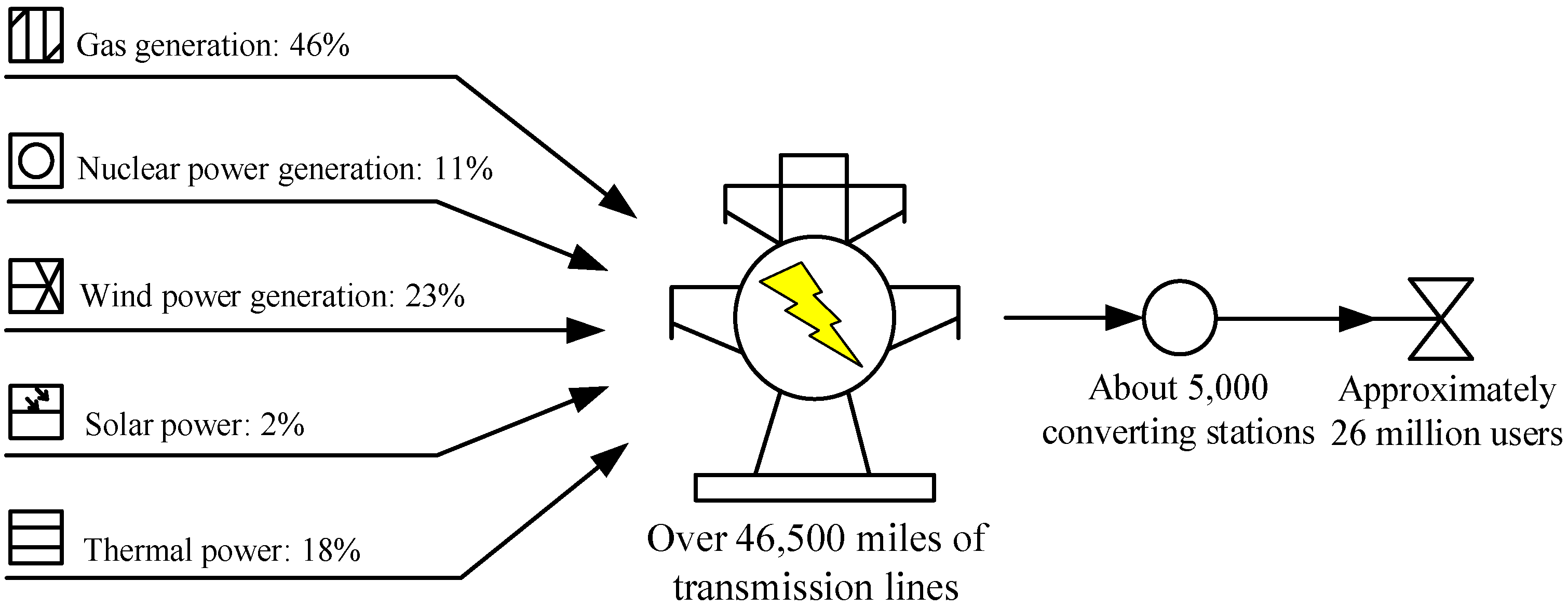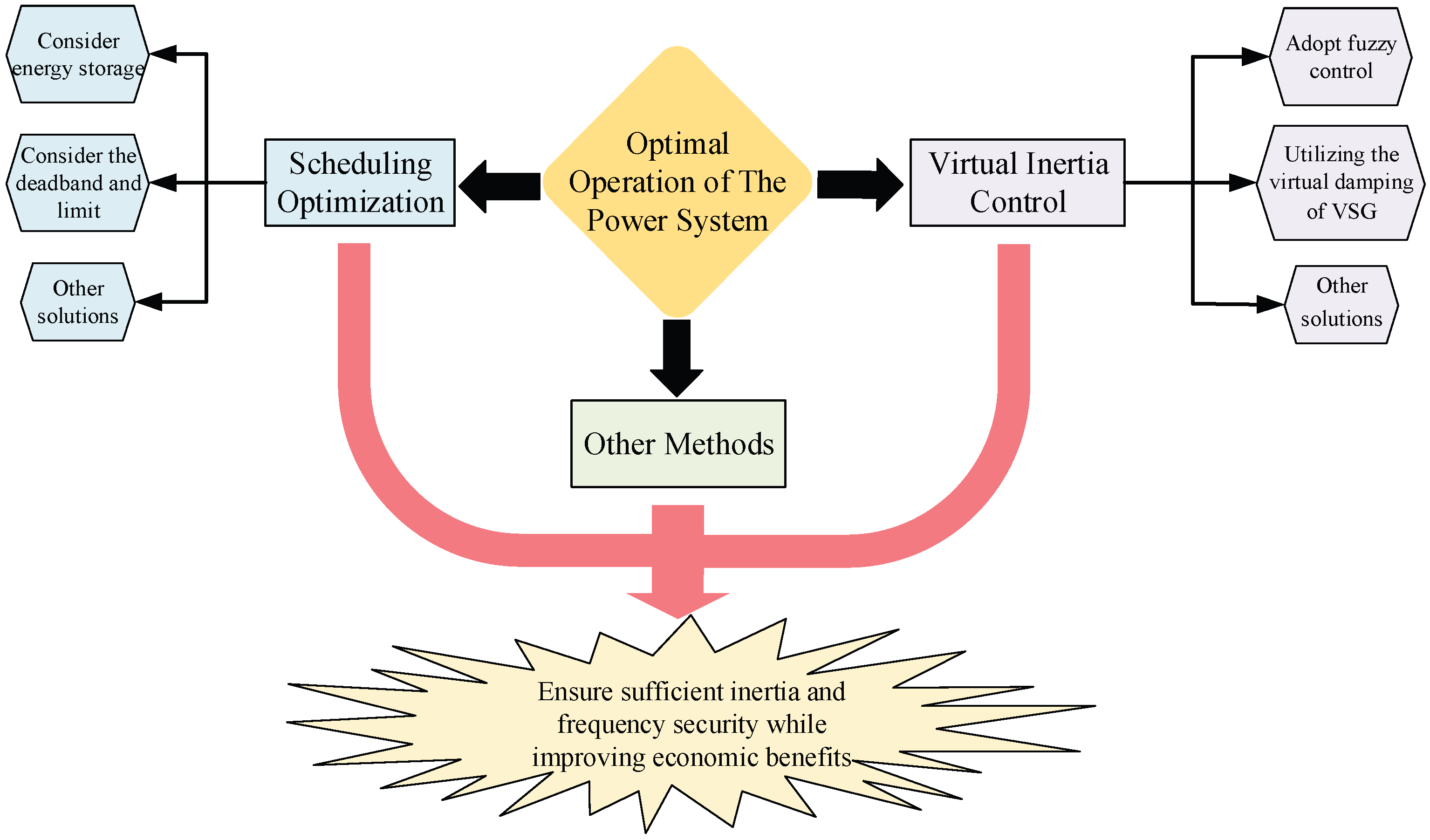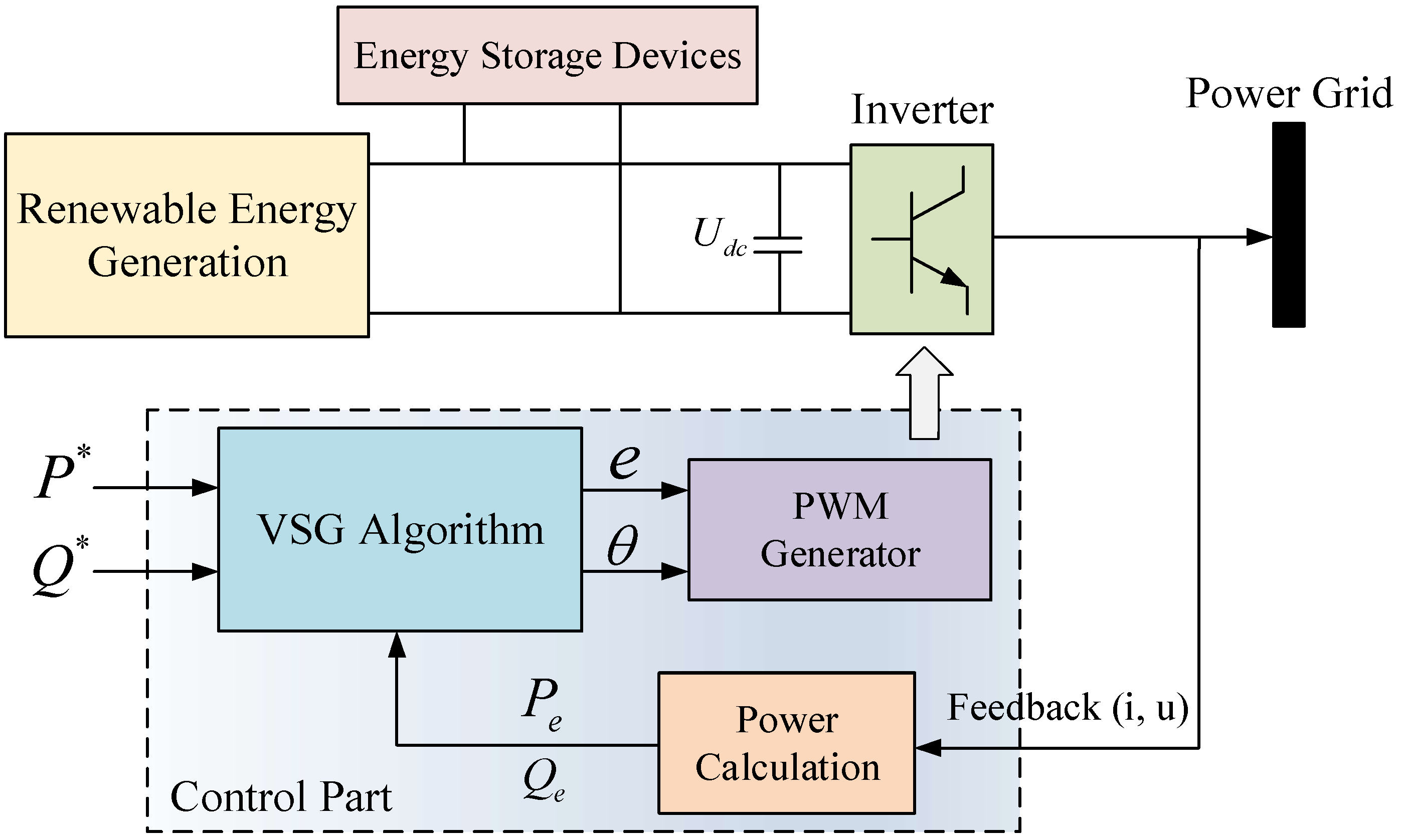Review of Low Inertia in Power Systems Caused by High Proportion of Renewable Energy Grid Integration
Abstract
:1. Introduction
- (1)
- Online evaluation of equivalent inertia: accurate and real-time assessment of system equivalent inertia based on large disturbance events, small disturbance events or quasi-steady-state operating conditions is essential to measure the resilience of power system with high proportion of renewable energy. This assessment helps detect the system’s supporting capacity, predict inertia level trends, provide guidance for optimizing system scheduling, and ensure the stability and safety of system operations (in Section 3).
- (2)
- Optimal scheduling: with the goal of improving the economic efficiency of system operation, with frequency security taken as the constraint, after considering various factors such as safety margin, the scheduling strategy of the power system is optimized to maximize the benefits brought by the grid integration of new energy (in Section 4.1).
- (3)
- Adopting virtual inertia control technology: regarding solar energy, wind energy and other new energy power generation, either because there is no mechanical rotary inertia or because it is decoupled from the grid, it is intuitively unable to provide inertia support for the power system. But in fact, through special means and control methods, new energy power generation can also play a certain role in frequency and voltage regulation, having inertia like thermal power units, which is called virtual inertia (in Section 4.2).
- (4)
- UFLS: in case of emergency due to accidents, load shedding shall be carried out to avoid further frequency drop and system collapse. When taking UFLS, factors such as the scale of system power deficiency and the importance of load should be considered comprehensively to determine which loads and the amount of loads to be shed (in Section 5).
2. Cases of Major Electrical Accidents Related to Low Inertia in Recent Years
2.1. The “8.9” Blackout in Britain
2.2. The “2.15” Blackout in Texas, USA
- (1)
- Establish a real-time communication system between the electricity and gas systems to quickly identify and address faults, thereby enhancing system resilience.
- (2)
- Accelerate the development of backup resources such as energy storage and gas storage facilities to alleviate the burden of dispatching and compensating for renewable energy systems. Additionally, establish emergency mechanisms for extreme energy supply events to minimize the losses and negative social impacts caused by accidents.
- (3)
- Fully leverage the response level of multi-energy resources on the demand side and enhance the flexible load regulation capacity based on external factors and supply–demand relationships, ensuring the optimal allocation of resources in a wider range and a greater variety of energy sources. Especially in emergency scenarios, the flexible regulation capabilities of end-users’ multi-energy loads can be fully utilized to ensure the secure operation of the power system on a larger scale.
3. Inertia Evaluation Methods for Power Systems
3.1. Inertia Evaluation Based on Large Disturbance Events
3.2. Inertia Evaluation Based on Small Disturbance Events
3.3. Inertia Evaluation Based on Quasi-Steady-State Operation
4. Optimal Operation Measures for Power Systems
4.1. Scheduling Optimization
4.2. Virtual Inertia Control
4.3. Other Optimization Methods
5. UFLS Schemes under Large-Scale Power Deficiency
6. Conclusions and Prospect
- (1)
- In terms of theoretical improvement: at present, the relevant theoretical analysis of the frequency response of the power system has been relatively complete, but the electromechanical dynamic process of the power system is very complicated because it is affected by the distribution of inertia. Future research can focus on exploring the coupling mechanism between the system’s electromechanical dynamic process and the space distribution of inertia, and it can provide a new vision for the stable operation of a high-proportion new energy power system.
- (2)
- In terms of inertia evaluation, research is conducted on comprehensive inertia detection and evaluation based on technologies such as big data and artificial intelligence. With the widespread application of high-performance devices such as PMUs, the accurate processing of large amounts of system data has become easier. In the future, an online high-precision detection model can be constructed based on real-time data such as grid node frequency, switch operating status, and the spatiotemporal distribution characteristics of inertia. Furthermore, starting from application scenarios, research is conducted on inertia evaluation and warning systems that meet the requirements of various levels, issuing warning messages regarding the insufficient inertia in both real-time and predictive operational modes.
- (3)
- In terms of grid integration and decoupling: in low-inertia power systems, the integration of a large number of distributed energy resources and energy storage devices has made the system structure more complex. Grid integration and decoupling issues have become a challenge in low inertia research, requiring research efforts to enhance the effective integration of distributed energy resources and energy storage devices while maintaining system stability and controllability.
- (4)
- In terms of simulation construction, due to the uniqueness of low-inertia power systems, the complexity of real situations and the diversity of unverified power system optimization methods, researchers need to continuously optimize and upgrade existing simulation platforms and algorithms in order to simulate real scenarios better and obtain accurate data.
- (5)
- In terms of emergency measures under large-scale power deficiency: researchers can explore the feasibility of taking additional measures before implementing UFLS rather than focusing all their efforts on mitigating the negative impacts and optimizing load-shedding strategies. For instance, in hydroelectric power plants, a reasonable generation scheduling can be designed by considering multiple sources of data and past experiences. This involves storing varying volumes of water based on different circumstances and releasing it during emergency situations to temporarily generate additional power for emergency use.
Author Contributions
Funding
Data Availability Statement
Conflicts of Interest
Abbreviations
| UFLS | Under Frequency Load Shedding |
| PV | Photovoltaic |
| PMU | Phasor Measurement Unit |
| WAMS | Wide Area Measurement System |
| RIES | Regional Integrated Energy System |
| IDR | Integrated Demand Response |
| RMSE | Root Mean Square Error |
| IES | Integrated Energy Systems |
| DE | Differential Evolution factor |
| ICA | Imperialist Competitive Algorithm |
| PWM | Pulse Width Modulation |
| VSG | Virtual Synchronous Generator |
| SOC | Storage state of Charge |
| DFIG | Doubly Fed Induction Generator |
| LQR | Line Quadratic Regulator |
| BP | Back Propagation |
| DC | Direct Current |
| EMD | Empirical Mode Decomposition |
| MCMC | Markov Chain Monte Carlo |
| ISR | Inertia Security Region |
| RoCoF | Rate of Change of Frequency |
References
- Zhang, Q.; Zhou, Q. Research on the Development Path of China’s Thermal Power Generation Technology Based on the Goal of “Carbon Peak and Carbon Neutralization”. Power Gener. Technol. 2023, 44, 143–154. [Google Scholar]
- Ren 21. Renewables 2022 Global Status Report [EB/OL]. Available online: https://www.ren21.net/gsr-2022/ (accessed on 20 April 2022).
- Tang, J.; Li, S. Analysis of the Influence of Grid-connected High Permeability New Energy on the Frequency Characteristics of Power Grid. Electr. Eng. 2023, 4, 58–62+133. [Google Scholar]
- Li, X.; Wu, G.; Yuan, X.; Wu, L. Research on Economic Evaluation of Renewable Energy Generation Side Energy Storage Projects. Electr. Power Sci. Eng. 2023, 1–12. [Google Scholar]
- Su, G.; Yi, H.; Kurban, A.; Guo, T.; Hao, W.; Huan, J. Multi-Objective capacity optimization of renewable energypower system considering techno-economic comparisons of various energy storage technologies. Acta Energiae Solaris Sin. 2022, 43, 424–431. [Google Scholar]
- Wang, Y.; Wang, X.; Lu, M. Research on Inertia Related Problems of High Proportion of New Energy. Northeast. Electr. Power Technol. 2023, 44, 20–27+46. [Google Scholar]
- Zhang, H.; Gao, Z.; Cao, Y.; Qin, H.; Yang, D.; Ma, H. Review and prospect of research on power system inertia with high-penetration of renewable energy source. J. Shandong Univ. (Eng. Sci.) 2022, 52, 1–13. [Google Scholar]
- Mehigan, L.; Al Kez, D.; Collins, S.; Foley, A.; Ó’Gallachóir, B.; Deane, P. Renewables in the European power system and the impact on system rotational inertia. Energy 2020, 203, 117776. [Google Scholar] [CrossRef]
- Zeng, H.; Sun, F.; Li, T.; Zhang, Q.; Tang, J.; Zhang, T. Analysis of “9.28” in South Australia and its enlightenment to China. Autom. Electr. Power Syst. 2017, 41, 1–6. [Google Scholar]
- Yan, R. The anatomy of the 2016 South Australia blackout: A catastrophic event in a high renewable network. IEEE Trans. Power Syst. 2018, 33, 5374–5388. [Google Scholar] [CrossRef]
- Zhang, W.; Wen, Y.; Chi, F.; Wang, K.; Li, L. Research Framework and Prospect on Power System Inertia Estimation. Proc. CSEE 2021, 41, 6842–6856. [Google Scholar]
- Liu, Z.; Zhou, M.; Li, Z. Fault recovery strategy of active distribution network based on mutation particle swarm opti-mization algorithm. Electr. Power Autom. Equip. 2021, 41, 1–11+53. [Google Scholar]
- Wang, B.; Yang, D.; Cai, G. Review of Research on Power System Inertia Related Issues in the Context of High Penetration of Renewable Power Generation. Power Syst. Technol. 2020, 44, 2998–3007. [Google Scholar]
- Teng, S.; Gong, Y.; Zhang, P.; Li, X. Analysis of Great Blackout Accident in Britain on August 9, 2019 and Enlightenment to Beijing Power Network. Electr. Power Surv. Des. 2020, 2, 5–8. [Google Scholar]
- Sun, H.; Xu, T.; Guo, Q.; Xi, G.; Zhang, J.Y.; Tu, J.Z. Analysis on Blackout in Great Britain Power Grid on August 9th, 2019 and Its Enlightenment to Power Grid in China. Proc. CSEE 2019, 39, 6183–6192. [Google Scholar]
- Hou, Y.; Ding, Y.; Bao, M.; Liang, Z.; Song, Y.; Guo, C. Analysis of Texas Blackout from the Perspective of Electricity-gas Coupling and Its Enlightenment to the Development of China’s New Power System. Proc. CSEE 2022, 42, 7764–7775. [Google Scholar]
- Zhang, G.; Zhong, H.; Tan, Z.; Cheng, T.; Xia, Q.; Kang, C. Texas electric power crisis of 2021 warns of a new blackout mechanism. CSEE J. Power Energy Syst. 2022, 8, 1–9. [Google Scholar]
- Menati, A.; Xie, L. A Preliminary Study on the Role of Energy Storage and Load Rationing in Mitigating the Impact of the 2021 Texas Power Outage. In Proceedings of the 2021 North American Power Symposium (NAPS), College Station, TX, USA, 14–16 November 2021; pp. 1–5. [Google Scholar]
- Song, G.; Bialek, J. Synchronous machine inertia constants updating using Wide Area Measurements. In Proceedings of the IEEE Pes International Conference & Exhibition on Innovative Smart Grid Technologies, Berlin, Germany, 14–17 October 2012. [Google Scholar]
- Xiao, Y.; Lin, X.; Wen, Y. Multi-Dimensional Assessment of the Inertia Level of Power Systems with High Penetration of HVDCs and Renewables. Electr. Power Constr. 2020, 41, 19–27. [Google Scholar]
- Liu, F.; Xun, G.; Wang, F. Assessment Method of System Partition Inertia Based on Differential Calculation Method. Autom. Electr. Power Syst. 2020, 44, 46–53. [Google Scholar]
- Zeng, F.; Zhang, J.; Zhou, Y. Online identification of inertia distribution in normal operating power system. IEEE Trans. Power Syst. 2020, 35, 3301–3304. [Google Scholar] [CrossRef]
- Liu, M.; Chen, J.; Milano, F. On-line inertia estimation for synchronous and non-synchronous devices. IEEE Trans. Power Syst. 2021, 36, 2693–2701. [Google Scholar] [CrossRef]
- Li, D.; Zhang, J.; Xu, B. Equivalent Inertia Assessment in Renewable Power System Considering Frequency Distribution Properties. Power Syst. Technol. 2020, 44, 2913–2921. [Google Scholar]
- Guo, S.; Norris, S.; Bialek, J. Adaptive parameter estimation of power system dynamic model using modal information. IEEE Trans. Power Syst. 2014, 29, 2854–2861. [Google Scholar] [CrossRef]
- Zhang, J.; Han, C. Online identification of power system equivalent inertia constant. IEEE Trans. Ind. Electron. 2017, 64, 8098–8107. [Google Scholar] [CrossRef]
- Panda, R.K.; Mohapatra, A.; Srivastava, S.C. Online estimation of system inertia in a power network utilizing synchrophasor measurements. IEEE Trans. Power Syst. 2019, 35, 3122–3132. [Google Scholar] [CrossRef]
- Cai, G.; Wang, B.; Yang, D. Inertia estimation based on observed electromechanical oscillation response for power systems. IEEE Trans. Power Syst. 2019, 34, 4291–4299. [Google Scholar] [CrossRef]
- Guo, X.; Bi, T.; Liu, F. Estimating maximum penetration level of renewable energy based on frequency stability constrains in networks with high-penetration wind and photovoltaic energy. Renew. Energy Resour. 2020, 38, 84–90. [Google Scholar]
- You, S.; Liu, Y.; Kou, G. Non-invasive identification of inertia distribution change in high renewable systems using distribution level PMU. IEEE Trans. Power Syst. 2017, 33, 1110–1112. [Google Scholar] [CrossRef]
- Zeng, F.; Zhang, J. Temporal and Spatial Characteristics of Power System Inertia and Its Analysis Method. Proc. CSEE 2020, 40, 50–58+373. [Google Scholar]
- Liu, Q.; Yu, Z.; Zhang, L. Online Frequency Support Capacity Assessment of Power Grid Based on Inertia Ratio. Power Syst. Technol. 2023, 47, 493–502. [Google Scholar]
- Cao, X.; Stephen, B.; Abdulhadi, I.F.; Booth, C.D.; Burt, G.M. Switching Markov Gaussian models for dynamic power system inertia estimation. IEEE Trans. Power Syst. 2015, 31, 3394–3403. [Google Scholar] [CrossRef]
- Li, D.; Guo, T.; Liu, Q. Inertia estimation of renewable power system considering photovoltaics. Acta Energiae Solaris Sin. 2021, 42, 174–179. [Google Scholar]
- Tuttelberg, K.; Kilter, J.; Wilson, D.; Uhlen, K. Estimation of power system inertia from ambient wide area measurements. IEEE Trans. Power Syst. 2018, 33, 7249–7257. [Google Scholar] [CrossRef]
- Li, S.; Xia, Z.; Cheng, X. Continuous Estimation Method of Power System Inertia Based on Ambient Disturbance. Proc. CSEE 2020, 40, 4430–4439+4723. [Google Scholar]
- Xu, Z.; Wang, C.; Zheng, H. Frequency constrained unit commitment and economic dispatch with storage in low-inertia power system. Adv. Technol. Electr. Eng. Energy 2020, 39, 25–32. [Google Scholar]
- Liu, J.; Jia, Y.; Chen, H. Market Mechanism and Scheduling Strategy of Ancillary Services Considering Real-time Frequency Regulation Requirements. Power Syst. Technol. 2022, 46, 1269–1278. [Google Scholar]
- Yang, H.; Li, M.; Jiang, Z.; Zhang, P. Multi-time scale optimal scheduling of regional integrated energy systems considering integrated demand response. IEEE Access 2020, 8, 5080–5090. [Google Scholar] [CrossRef]
- Cao, S.; Wu, X.; Liu, J. Scheduling Optimization Control Strategy of PV-and-Storage Combined Power Generation System. Electr. Mach. Control Appl. 2023, 50, 89–94. [Google Scholar]
- Xu, T.; Cheng, C.; Ren, F. Optimal Scheduling of Integrated Energy Systems Considering Carbon Trading. J. Phys. Conf. Ser. 2022, 2395, 012053. [Google Scholar] [CrossRef]
- Xin, X.; Wang, T.; Gu, X. Unit Commitment and Risk Dispatch Considering Multi-Regional Frequency Dynamic Security Under Large-scale Wind Power Access. Proc. CSEE 2023, 1–16. [Google Scholar]
- Shen, J.; Li, W.; Li, Z. Unit Commitment of Power System with High Proportion of Wind Power Considering the Deadband and Limiter of Primary Frequency Response. Power Syst. Technol. 2022, 46, 1326–1337. [Google Scholar]
- Wang, Y.; Wang, Y.; Zhao, Z.; Zhou, Z.; Hou, Z. Multi-Timescale Optimal Operation Strategy for Renewable Energy Power Systems Based on Inertia Evaluation. Energies 2023, 16, 3577. [Google Scholar] [CrossRef]
- Wu, X.; Cao, S.; An, T. Multi-Objective Scheduling Optimization Strategy of Regional Power Grid Considering the Influence of Weighting Factors. Electr. Mach. Control Appl. 2023, 50, 81–88. [Google Scholar]
- Zeng, M.; Peng, L.; Wang, L. Two-stage dual-level dispatch optimization model of distributed energy system in active distribution network. Electr. Power Autom. Equip. 2016, 36, 108–115. [Google Scholar]
- Zhang, X.; Hu, J.; Fu, Y. Virtual Inertia Demand and Collaborative Support Technology of Wind Power and Energy Storage System. Trans. China Electrotech. Soc. 2023, 1–14. [Google Scholar]
- Xu, B.; Zhang, L.; Yao, Y.; Yu, X.; Yang, Y.; Li, D. Virtual Inertia Coordinated Allocation Method Considering Inertia Demand and Wind Turbine Inertia Response Capability. Energies 2021, 14, 5002. [Google Scholar] [CrossRef]
- Fu, S.; Sun, Y.; Liu, Z. Power oscillation suppression in multi-VSG grid with adaptive virtual inertia. Int. J. Electr. Power Energy Syst. 2021, 135, 107472. [Google Scholar] [CrossRef]
- Zhang, X.; Li, D.; Yang, Z. Fuzzy adaptive virtual inertia control of energy storage systems considering SOC constraints. Energy Rep. 2023, 9, 2431–2439. [Google Scholar] [CrossRef]
- Zhang, X.; Jin, Z.; Fu, Y. Virtual Inertia Constrain and Support Control of Wind Turbines Based on Variable Frequency Limit Time. High Volt. Eng. 2023, 49, 2491–2505. [Google Scholar]
- Ke, X.; Zhang, W.; Li, P. Fuzzy Adaptive Virtual Inertia Control for High Wind Power Penetration System. Power Syst. Technol. 2020, 44, 2127–2136. [Google Scholar]
- Li, H.; Lu, G.; Zhou, L. Adaptive Virtual Inertia Control of New Energy Based on LQR. Electr. Drive 2023, 1–7. [Google Scholar]
- Wang, Z.; Gao, J.; Zhao, B. Wind farm virtual inertia coordinated control technology based on wind speed prediction. Acta Energiae Solaris Sin. 2020, 44, 2127–2136. [Google Scholar]
- Yang, T.; Liao, Y. Coordinated control method of virtual inertia and virtual damping for interconnected power system with doubly-fed wind farm. Electr. Power Autom. Equip. 2020, 40, 92–100. [Google Scholar]
- Wang, Q.; Yao, L.; Xu, J. S-MCMC Based Equivalent Inertia Probability Evaluation for Power Systems with High Proportional Renewable Energy. Power Syst. Technol. 2023, 1–13. [Google Scholar]
- Lin, X.; Wen, Y.; Yang, W. Inertia Security Region: Concept, Characteristics, and Assessment Method. Proc. CSEE 2021, 41, 3065–3079. [Google Scholar]
- Sun, D.; Wang, B.; Li, W. Research on Inertia System of Frequency Response for Power System with High Penetration Electronics. Proc. CSEE 2020, 40, 5179–5192. [Google Scholar]
- Song, Z.; Liu, J.; Liu, Y. Response model of DFIG for real-time simulation of large-scale wind farms. Electr. Power Autom. Equip. 2014, 34, 95–100+119. [Google Scholar]
- Bo, D.; He, J.; Wang, X. Adaptive UFLS scheme based on grey correlation analysis. Power Syst. Prot. Control 2014, 42, 20–25. [Google Scholar]
- Tan, W.; Yi, Y.; Lin, J. A New Low-frequency Load Shedding Scheme Based on Ordered Binary Decision Diagram. Guangdong Electr. Power 2014, 27, 79–83. [Google Scholar]
- Xie, D.; He, H.; Chang, X. An Approach to Design Power System under Frequency Load Shedding Scheme Taking Coherent Area and Global Optimization into Account. Power Syst. Technol. 2010, 34, 106–112. [Google Scholar]
- Gao, X.; Yao, L.; Zhang, H. Under Frequency Load Shedding Scheme Optimization Based on Load Frequency Characteristics. Proc. CSU-EPSA 2015, 27, 82–88. [Google Scholar]
- Liu, K.; Zhang, J.; Li, J. Power Deficit Calculation and under Frequency Load Shedding Strategy Based on the Frequency Deviation Area. Trans. China Electrotech. Soc. 2021, 36, 1040–1051. [Google Scholar]
- Wang, H.; He, P.; Jiang, Y. Under-frequency load shedding scheme based on estimated inertia. Electr. Power Autom. Equip. 2019, 39, 51–56+63. [Google Scholar]
- Liu, Y.; Chen, M.; Li, J. Monotonic control characteristics of under-frequency load shedding in power system. Electr. Power Autom. Equip. 2023, 43, 182–189. [Google Scholar]
- Shazon, M.N.H.; Deeba, S.R.; Modak, S.R. A Frequency and Voltage Stability-Based Load Shedding Technique for Low Inertia Power Systems. IEEE Access 2021, 9, 78947–78961. [Google Scholar]







| Reference Number | Category | Advantages | Disadvantages |
|---|---|---|---|
| [35] | Scheduling optimization | Considers energy storage, adopts model prediction control | Ignores that the frequency of bus in the power systems is not completely the same |
| [36] | Scheduling optimization | Proposes a compensation mechanism of frequency regulation ancillary services based on demand tightness to reduce the cost | The proposed mechanism may lead to a decrease in the economic benefits of energy storage frequency regulation when the frequency regulation demand is small |
| [39] | Scheduling optimization | Proposes a two-stage risk scheduling model, which balances economy and security | Only suitable for multi-regional systems with a high proportion of wind power and a large gap in the wind power resources distribution |
| [40] | Scheduling optimization | Takes the influence of primary frequency regulation dead zone and amplitude limit into consideration | Due to the highly nonlinearity of the constructed frequency security constraints, although the proposed algorithm can improve the quality of the optimized solution, it cannot guarantee that it is the optimal one |
| [48] | Virtual inertia control | Improves the credibility of wind turbine inertia evaluation, proposes a virtual inertia control strategy to meet the frequency regulation requirements | Improves the credibility but does not propose an accurate method for evaluating the virtual inertia of wind turbines |
| [49] | Virtual inertia control | Introduces fuzzy control into virtual inertia control for wind–thermal systems, enables wind turbines to supply inertia under various operating conditions | As the proportion of wind power generation increases in power systems, the secondary drop in frequency becomes increasingly severe |
| [53] | Other methods | Proposes a new equivalent inertia probability evaluation method for power systems to effectively reflect the time-series change trend of the inertia | Ignores the impact of energy storage in power systems on the equivalent inertia evaluation |
| Region | System Scale | UFLS Threshold/Hz | Maximum Load/GW | Security Index | Time Precision |
|---|---|---|---|---|---|
| Texas | Large interconnected system | 59.3 | 73 | RoCoF | Hour |
| South Australia | Large island | 47.6 | 3.4 | — | Daily/Monthly |
| Ireland | Small island | 48.9 | 6.5 | — |
Disclaimer/Publisher’s Note: The statements, opinions and data contained in all publications are solely those of the individual author(s) and contributor(s) and not of MDPI and/or the editor(s). MDPI and/or the editor(s) disclaim responsibility for any injury to people or property resulting from any ideas, methods, instructions or products referred to in the content. |
© 2023 by the authors. Licensee MDPI, Basel, Switzerland. This article is an open access article distributed under the terms and conditions of the Creative Commons Attribution (CC BY) license (https://creativecommons.org/licenses/by/4.0/).
Share and Cite
Song, J.; Zhou, X.; Zhou, Z.; Wang, Y.; Wang, Y.; Wang, X. Review of Low Inertia in Power Systems Caused by High Proportion of Renewable Energy Grid Integration. Energies 2023, 16, 6042. https://doi.org/10.3390/en16166042
Song J, Zhou X, Zhou Z, Wang Y, Wang Y, Wang X. Review of Low Inertia in Power Systems Caused by High Proportion of Renewable Energy Grid Integration. Energies. 2023; 16(16):6042. https://doi.org/10.3390/en16166042
Chicago/Turabian StyleSong, Jiyu, Xinhang Zhou, Zhiquan Zhou, Yang Wang, Yifan Wang, and Xutao Wang. 2023. "Review of Low Inertia in Power Systems Caused by High Proportion of Renewable Energy Grid Integration" Energies 16, no. 16: 6042. https://doi.org/10.3390/en16166042
APA StyleSong, J., Zhou, X., Zhou, Z., Wang, Y., Wang, Y., & Wang, X. (2023). Review of Low Inertia in Power Systems Caused by High Proportion of Renewable Energy Grid Integration. Energies, 16(16), 6042. https://doi.org/10.3390/en16166042






